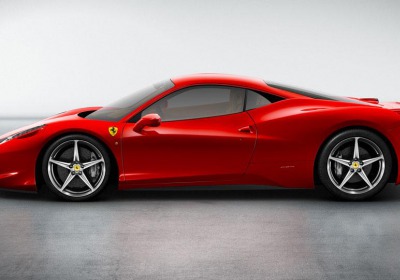Ferrari 458 Italia is the latest masterpiece from Maranello
Tue, 28 Jul 2009
Ferrari has drawn from the visual spirit of the Enzo to create a power-packed replacement for the F430 that shuns the rounded curves of its past V8s in favor of chiseled, unmistakable aggression.
Boasting a new 4.5-liter V8 engine, a seven-speed dual-clutch gearbox and a 202-mph top speed, Ferrari has revealed that the car--code-named F142 and long rumored to be named the F450--will be called the 458 Italia. Following Ferrari lore, it stands for a 4.5-liter engine with eight cylinders, though why Ferrari thought people would forget it came from Italy is anybody's guess.
The Ferrari 458 Italia will be unveiled on Sept. 8 at the Frankfurt motor show. It has been heavily sculpted for aerodynamic efficiency and has picked up more racing technology than any Ferrari before.
Ferrari claims the engine has the highest specific output in the motoring world. It produces so much power from the all-alloy, direct-injection V8 that its specific output has smashed the old 100-hp-per-liter mark and is pushing beyond even high-output turbocharged cars.
Where Audi's twin-turbo RS6 V10 huffs and puffs its way to 114 hp per liter, Ferrari's high-compression V8 howls out 127 hp per liter.
The high-revving V8 has light internal parts and tiny piston skirts, resulting in low-rotation inertia, a 12.5:1 compression ratio and it rips out 570 hp at an astonishing 9,000 rpm.
No Ferrari road car has ever revved higher and had a higher specific output.
It means that the 458 Italia will be ferociously fast, with Ferrari claiming that it will sprint to 62 mph in less than 3.5 seconds.
While advanced engine electronics are one key to the extra performance, it is also the first rear-mid-engine application of the direct-injection fuel system, which debuted on the front-mid-engine California, and it also runs Ferrari's now-traditional flat-plane crankshaft.
It will be one of the most flexible Ferraris in history, too, with 398 lb-ft of torque arriving at 6,000 rpm. While that sounds peaky, remember that it's only two-thirds of the way up the 458 Italia's rev range and that 319 of those pound-feet will be turning the ultralight flywheel from as little as 3,250 rpm.
Ferrari has clearly worked to produce an engine with a tremendous range of abilities, from record-setting specific outputs to enough torque to surge away from low engine speeds.
The direct fuel injection also helped with Ferrari's environmental challenges, producing a claimed 320 grams of CO2 per kilometer, even though it is faster and produces significantly more power than the 483-hp F430 or the 508-hp F430 Scuderia.
Ferrari learned much developing the seven-speed dual-clutch gearbox for the California, and it has had to learn more to make the unit fit into the 458 Italia's engine bay, behind the curvaceous hatch.
While the Scuderia sliced gearshift times down to 0.06 second, the dual-clutch unit is even faster and is so close to being a seamless shift, it's hardly worth bickering over the couple of wavelengths of caesium resonance. Its ratios are different from the California's, too, with a focus more on aggression than the philosophically softer convertible.
The E-Diff differential and the F1-Trac skid-control system have long been the flagship carryover technologies from Formula One, but the 458 Italia takes them even further.
Instead of using their own electronic control units to communicate, Ferrari has given the 458 Italia one ECU to control both systems, resulting in streamlined processing and communication.
Also in charge of the ABS system, it's an ECU that Ferrari claims gives the 458 Italia a 32 percent increase in longitudinal acceleration over the F430 out of corners--and the F430 was no slouch. Its control over braking is said to cut the stopping distance from 62 mph to just 107 feet.
Ferrari had felt, with some justification, that the suspension geometry of the F430 Scuderia was near perfection, and the 458 Italia is said to be a step forward from there. It's based on a double-wishbone front suspension and a multilink rear end, all bolted directly to the all-aluminum chassis. It's all been developed with heavy assistance by Michael Schumacher, who was even caught by spy photographers testing the car near the N
By Michael Taylor

